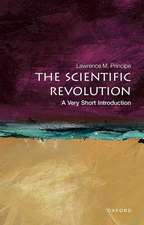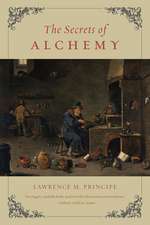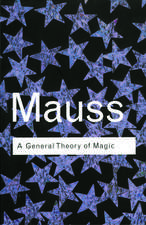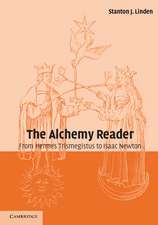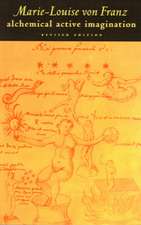Alchemy Tried in the Fire: Starkey, Boyle, and the Fate of Helmontian Chymistry
Autor William R. Newman, Lawrence M. Principeen Limba Engleză Paperback – 30 iun 2005
Winner of the 2005 Pfizer Prize from the History of Science Society.
What actually took place in the private laboratory of a mid-seventeenth century alchemist? How did he direct his quest after the secrets of Nature? What instruments and theoretical principles did he employ?
Using, as their guide, the previously misunderstood interactions between Robert Boyle, widely known as "the father of chemistry," and George Starkey, an alchemist and the most prominent American scientific writer before Benjamin Franklin as their guide, Newman and Principe reveal the hitherto hidden laboratory operations of a famous alchemist and argue that many of the principles and practices characteristic of modern chemistry derive from alchemy. By analyzing Starkey's extraordinary laboratory notebooks, the authors show how this American "chymist" translated the wildly figurative writings of traditional alchemy into quantitative, carefully reasoned laboratory practice—and then encoded his own work in allegorical, secretive treatises under the name of Eirenaeus Philalethes. The intriguing "mystic" Joan Baptista Van Helmont—a favorite of Starkey, Boyle, and even of Lavoisier—emerges from this study as a surprisingly central figure in seventeenth-century "chymistry." A common emphasis on quantification, material production, and analysis/synthesis, the authors argue, illustrates a continuity of goals and practices from late medieval alchemy down to and beyond the Chemical Revolution.
For anyone who wants to understand how alchemy was actually practiced during the Scientific Revolution and what it contributed to the development of modern chemistry, Alchemy Tried in the Fire will be a veritable philosopher's stone.
What actually took place in the private laboratory of a mid-seventeenth century alchemist? How did he direct his quest after the secrets of Nature? What instruments and theoretical principles did he employ?
Using, as their guide, the previously misunderstood interactions between Robert Boyle, widely known as "the father of chemistry," and George Starkey, an alchemist and the most prominent American scientific writer before Benjamin Franklin as their guide, Newman and Principe reveal the hitherto hidden laboratory operations of a famous alchemist and argue that many of the principles and practices characteristic of modern chemistry derive from alchemy. By analyzing Starkey's extraordinary laboratory notebooks, the authors show how this American "chymist" translated the wildly figurative writings of traditional alchemy into quantitative, carefully reasoned laboratory practice—and then encoded his own work in allegorical, secretive treatises under the name of Eirenaeus Philalethes. The intriguing "mystic" Joan Baptista Van Helmont—a favorite of Starkey, Boyle, and even of Lavoisier—emerges from this study as a surprisingly central figure in seventeenth-century "chymistry." A common emphasis on quantification, material production, and analysis/synthesis, the authors argue, illustrates a continuity of goals and practices from late medieval alchemy down to and beyond the Chemical Revolution.
For anyone who wants to understand how alchemy was actually practiced during the Scientific Revolution and what it contributed to the development of modern chemistry, Alchemy Tried in the Fire will be a veritable philosopher's stone.
Preț: 320.42 lei
Nou
Puncte Express: 481
Preț estimativ în valută:
61.31€ • 64.01$ • 50.74£
61.31€ • 64.01$ • 50.74£
Carte tipărită la comandă
Livrare economică 05-19 aprilie
Preluare comenzi: 021 569.72.76
Specificații
ISBN-13: 9780226577029
ISBN-10: 0226577023
Pagini: 359
Ilustrații: 7 halftones
Dimensiuni: 152 x 229 x 15 mm
Greutate: 0.47 kg
Editura: University of Chicago Press
Colecția University of Chicago Press
ISBN-10: 0226577023
Pagini: 359
Ilustrații: 7 halftones
Dimensiuni: 152 x 229 x 15 mm
Greutate: 0.47 kg
Editura: University of Chicago Press
Colecția University of Chicago Press
Notă biografică
William R. Newman is professor of history and philosophy of science at Indiana University. He is the author of The Summa Perfectionis of Pseudo-Geber: A Critical Edition, Translation, and Study and Gehennical Fire: The Lives of George Starkey, An American Alchemist in the Scientific Revolution.
Lawrence M. Principe is professor of the history of science and technology and of chemistry at The Johns Hopkins University. He is the author of The Aspiring Adept: Robert Boyle and His Alchemical Quest and coeditor of The Correspondence of Robert Boyle.
Lawrence M. Principe is professor of the history of science and technology and of chemistry at The Johns Hopkins University. He is the author of The Aspiring Adept: Robert Boyle and His Alchemical Quest and coeditor of The Correspondence of Robert Boyle.
Cuprins
List of Figures
Acknowledgments
Preface
Abbreviations
Introduction
Chapter 1 - Worlds Apart
Boyle's Portrayal of His Relationship to Chymistry
Conclusions
Chapter 2 - Number, Weight, Measure, and Experiment in Chymistry: From the Medievals to Van Helmont
Testing, Analysis, and Assaying in Late Medieval Alchemy
Alexander von Suchten and the Sixteenth-Century Synthesis of Chymical Traditions
Joan Baptista Van Helmont: Art, Nature, and Experiment
Conclusions
Chapter 3 - Theory and Practice: Starkey's Laboratory Methodology
The Use and Format of Starkey's Notebooks
Starkey's Laboratory
Starkey's Experimental Methodology: Conjectural Processes and Fiery Refutations
Quantitative Methods and Analyses in Transmutational Alchemy
The Volatilization of Alkalies and Starkey's Grand Design for Medicine
Conclusions
Chapter 4 - Scholasticism, Metallurgy, and Secrecy in the Laboratory: The Style and Origin of Starkey's Notebooks
Sources of Starkey's Industrial Chymistry
The Structure of Starkey's Laboratory Notebooks
Starkey and Textual Authority
The Place of Divine Authority in the Laboratory
Conclusions
Chapter 5 - Starkey, Boyle, and Chymistry in the Hartlib Circle
George Starkey and the Development of Boyle's Early Chymistry
The Role of Benjamin Worsley in Boyle's “Chymical Education”
Hartlib's “Chymical Son” Frederick Clodius and Boyle
Conclusions
Chapter 6 - The Legacy of Van Helmont's and Starkey's Chymistry: Boyle, Homberg, and the Chemical Revolution
The Chymistry of Salts in Boyle and Van Helmont
A Helmontian Background to the Chemical Revolution
Conclusions
Conclusion
Works Cited
Index
Acknowledgments
Preface
Abbreviations
Introduction
Chapter 1 - Worlds Apart
Boyle's Portrayal of His Relationship to Chymistry
Conclusions
Chapter 2 - Number, Weight, Measure, and Experiment in Chymistry: From the Medievals to Van Helmont
Testing, Analysis, and Assaying in Late Medieval Alchemy
Alexander von Suchten and the Sixteenth-Century Synthesis of Chymical Traditions
Joan Baptista Van Helmont: Art, Nature, and Experiment
Conclusions
Chapter 3 - Theory and Practice: Starkey's Laboratory Methodology
The Use and Format of Starkey's Notebooks
Starkey's Laboratory
Starkey's Experimental Methodology: Conjectural Processes and Fiery Refutations
Quantitative Methods and Analyses in Transmutational Alchemy
The Volatilization of Alkalies and Starkey's Grand Design for Medicine
Conclusions
Chapter 4 - Scholasticism, Metallurgy, and Secrecy in the Laboratory: The Style and Origin of Starkey's Notebooks
Sources of Starkey's Industrial Chymistry
The Structure of Starkey's Laboratory Notebooks
Starkey and Textual Authority
The Place of Divine Authority in the Laboratory
Conclusions
Chapter 5 - Starkey, Boyle, and Chymistry in the Hartlib Circle
George Starkey and the Development of Boyle's Early Chymistry
The Role of Benjamin Worsley in Boyle's “Chymical Education”
Hartlib's “Chymical Son” Frederick Clodius and Boyle
Conclusions
Chapter 6 - The Legacy of Van Helmont's and Starkey's Chymistry: Boyle, Homberg, and the Chemical Revolution
The Chymistry of Salts in Boyle and Van Helmont
A Helmontian Background to the Chemical Revolution
Conclusions
Conclusion
Works Cited
Index




